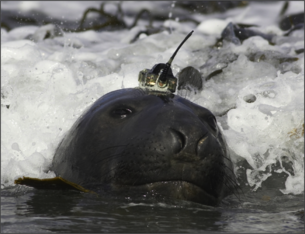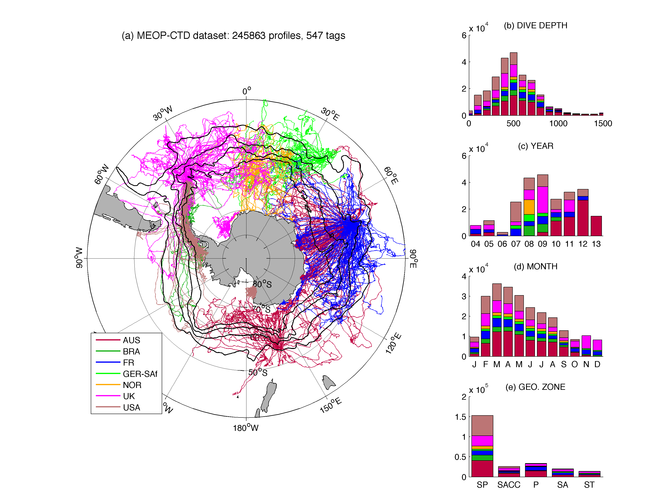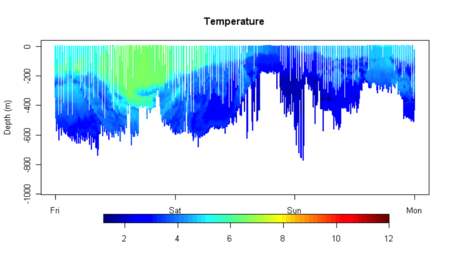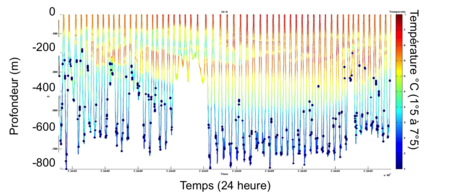Since 2004, several hundred seals have been equipped with conductivity-temperature-depth (CTD) sensors in the Southern Ocean for both biological and physical oceanographic studies. A calibrated collection of seal-derived hydrographic data is now available from Coriolis, currently consisting of more than 300,000 temperature/salinity profiles.
Overview
The Southern Ocean plays a fundamental role in regulating the global climate. This ocean also contains a rich and highly productive ecosystem, potentially vulnerable to climate change. Very large national and international efforts are directed towards the modeling of physical oceanographic processes to predict the response of the Southern Ocean to global climate change and the role played by the large-scale ocean climate processes. However, these modeling efforts are greatly limited by the lack of in situ measurements, especially at high latitudes and during winter months. The standard data that are needed to study ocean circulation are vertical profiles of temperature and salinity, from which we can deduce the density of seawater. These are collected with CTD (Conductivity-Temperature-Depth) sensors that are usually deployed on research vessels or, more recently, on autonomous Argo profilers. The use of conventional research vessels to collect these data is very expensive, and does not guarantee access to areas where sea ice is found at the surface of the ocean during the winter months. A recent alternative is the use of autonomous Argo floats. However, this technology is not easy to use in glaciated areas.
Figure 1 : Elephant seal with CTD tag© C.Guinet CEBC/CNRS
In this context, the collection of hydrographic profiles from CTDs mounted on marine mammals is very advantageous. The choice of species, gender or age can be done to selectively obtain data in particularly under-sampled areas such as under the sea ice or on continental shelves. Among marine mammals, elephant seals are particularly interesting. Indeed, they have the particularity to continuously dive to great depths (590 ± 200 m, with maxima around 2000 m) for long durations (average length of a dive 25 ± 15 min, maximum 80 min). A Conductivity-Temperature-Depth Satellite Relay Data Logger (CTD-SRDLs) has been developed in the early 2000s to sample temperature and salinity vertical profiles during marine mammal dives (Boehme et al. 2009, Fedak 2013). The CTD-SRDL is attached to the seal on land, then it records hydrographic profiles during its foraging trips, sending the data by satellite ARGOS whenever the seal goes back to the surface.
While the principle intent of seal instrumentation was to improve understanding of seal foraging strategies (Biuw et al., 2007), it has also provided as a by-product a viable and cost-effective method of sampling hydrographic properties in many regions of the Southern Ocean (Charrassin et al., 2008; Roquet et al., 2013).
International seal observing programs
After the international research program Southern Elephant seals as Oceanographic Samplers (SEaOS) initiated in 2004, the MEOP (Marine Mammals Exploring the Oceans Pole to Pole) project started as an International IPY (International Polar Year) project, aiming at coordinating the cooperation between several national programmes to provide a comprehensive, synoptic oceanographic coverage in Polar Regions. Here we provide a list of institutions that made a critical contribution to the funding of CTD-SRDL and to the logistics of seal deployments in the Southern Ocean, as part of the MEOP consortium: National Oceanographic Partnership Program, Office of Polar Program, National Science Foundation, and NOAA Antarctic Marine Living Resources Program (USA), the Norwegian Polar Institute and Research Council of Norway (NOR), the Natural Environment Research Council (UK), the Integrated Marine Observing System (AUS), the Centre National d’Etudes Spatiales and Institut Paul-Emile Victor (FR), the South African National Antarctic Programme (ZA), the Brazilian National Research Council (BRA), the International Governance and Atlantic Seal Research Program, Fisheries and Oceans, Canada and the Greenland Institute of Natural Resources (CAN), the Chinese Arctic and Antarctic Administration (China) and the Alfred Wegener Institute for Polar and Marine Research (GER).
The French MEMO Observatory "Mammifère marin Echantillonneur du Milieu Océanique" (Marine mammal, sample-taker of the marine environment) was set up in 2010 to continue acquisition of high-frequency data over the next ten years. The implementation of this program and its continuation as an ecological and oceanographic observatory of the Southern Ocean should allow scientists to know more about the secrets of elephant seals species and their environment. The French community has been strongly involved at a very early stage of the seal program, in particular for the optimization of transmitted data compression methods, the quality control of data collected (Roquet et al. 2011), and the development of fluorescence sensors with financial support of the Fondation Total (Guinet et al. 2013; Blain et al. 2013). French deployments have been carried out mainly at the Kerguelen Islands (Southern Indian Ocean). Several deployment campaigns have also been done on Weddell seals by J.-B. Charrassin (MNHN) in Adelie Land, Antarctica.
The value of these hydrographic data within the existing Southern Ocean observing system has recently been demonstrated (Roquet et al., 2013; Roquet et al., 2014). Using seal-derived data to constrain a model simulation of the ocean circulation substantially modified the estimated surface mixed- layer properties and circulation patterns in the Southern Ocean, improving the agreement of the model simulation with independent satellite observations of sea-ice concentration.
Globally :
- between 100 to 200 elephant seals are equipped with CTD each year
- among which 25 to 40 evolve in the Kerguelen Islands
- Data collected thanks to elephant seals represent the primary source of temperature and salinity data collected in Antarctic Sea-Ice (98 %) and 80% of the temperature and salinity data south of 60°S
- other parameters such as chlorophyll concentration are also available
Delayed-mode procedure
A post-processing procedure is applied on these data in order to ensure the best possible data quality (see Roquet et al., 2011). More information can be found on the MEOP portal website. This includes :
- tag-by-tag data visualization and editing of profiles (semi-automatic procedure)
- adjustment of salinity profile data. These corrections are determined based on comparisons with historical CTD and Argo data, or by cross-comparison between different tag datasets. Adjustments applied on salinity data are critical to achieve the accuracy needed for oceanographic and climatic studies.
- adjustment of temperature profile data, when possible. In practice, it is only possible to adjust temperature data in the case where seals foraged in freezing cold waters, allowing to use the known freezing temperature as a reference.
- storage of data using a slightly modified version of the netcdf Argo format, allowing to save in a single file the raw and adjusted pressure, temperature, and salinity data with their associated flags and metadata.
Coriolis contribution
Thanks to a collaboration with Fabien Roquet (Stockholm University) and the LOCEAN UPMC-CNRS-MNHN, CORIOLIS ensures the collection, quality-control and distribution of oceanographic (T/S) and biological (oxygen, fluorescence) data in both real and delayed-time mode
Data access
Data are available :
-
Delayed mode data, Deecmber 2014
http://dx.doi.org/10.12770/0a82d60c-683d-47b8-8bd1-24933ec24983 -
on the Coriolis ftp server, in /ifremer/marine_mammals/.
In a near future (summer 2015), seal data will be updated daily, and a monthly snapshot of the full database will be produced. - through the Coriolis data selection tool (Sea mammal or Animal profiles).
How to cite
Please cite the following papers if you use marine mammal data in a publication:
- Roquet F., Williams G., Hindell M. A., Harcourt R., McMahon C. R., Guinet C., Charrassin J.-B., Reverdin G., Boehme L., Lovell P. and Fedak M. A., 2014. A Southern Indian Ocean database of hydrographic profiles obtained with instrumented elephant seals. Nature Scientific Data, 1:140028, doi: 10.1038/sdata.2014.28.
- Roquet F., Wunsch C., Forget G., Heimbach P., Guinet C., Reverdin G., Charrassin J.-B., Bailleul F., Costa D. P., Huckstadt L. A., Goetz K. T., Kovacs K. M., Lydersen C., Biuw M., Nøst O. A., Bornemann H., Ploetz, J., Bester M. N., Mcintyre T., Muelbert M. C., Hindell M. A., McMahon C. R., Williams G., Harcourt R., Field I. C., Chafik L., Nicholls K. W., Boehme L., and Fedak M. A., 2013. Estimates of the Southern Ocean General Circulation Improved by Animal-Borne Instruments. Geoph. Res. Letts., 40:1-5. doi: 10.1002/2013GL058304
For any questions or comments on the data, please don't hesitate to contact Fabien Roquet (fabien.roquet_at_gmail.com).
High-resolution temperature data
Figure 3 : Section of high temperature resolution (2 Hz) obtained from four day dives by an elephant seal in the Antarctic area (East Kerguelen) and revealing the water column thermal structure at very fine scale. © MEMO
Figure 4 : Illustration of SO-MEMO ecological component : the simultaneous collection, during dives, of physical data (here as the water temperature) with evaluation of catch prey (represented by the blue dots) collected using accelerometers deployed on the head of elephant sea, can address cross-disciplinary matter such as the study of the distribution / structuring of marine resources in the physical and biogeochemical parameters (Chla) of the water column. © MEMO
References
- Roquet F., Williams G., Hindell M. A., Harcourt R., McMahon C. R., Guinet C., Charrassin J.-B., Reverdin G., Boehme L., Lovell P. and Fedak M. A., 2014. A Southern Indian Ocean database of hydrographic profiles obtained with instrumented elephant seals. Nature Scientific Data, 1:140028, doi: 10.1038/sdata.2014.28. Data available from BODC.
- Roquet F., Wunsch C., Forget G., Heimbach P., Guinet C., Reverdin G., Charrassin J.-B., Bailleul F., Costa D. P., Huckstadt L. A., Goetz K. T., Kovacs K. M., Lydersen C., Biuw M., Nøst O. A., Bornemann H., Ploetz, J., Bester M. N., Mcintyre T., Muelbert M. C., Hindell M. A., McMahon C. R., Williams G., Harcourt R., Field I. C., Chafik L., Nicholls K. W., Boehme L., and Fedak M. A., 2013. Estimates of the Southern Ocean General Circulation Improved by Animal-Borne Instruments. Geoph. Res. Letts., 40:1-5. doi: 10.1002/2013GL058304
- Guinet, C., Xing, X., Walker, E., Monestiez, P., Marchand, S., Picard, B., Jaud, T., Authier, M., Cotte, C., Dragon, A. C., Diamond, E., Antoine, D., Lovell, P., Blain, S., D'Ortenzio, F., and Claustre, H., 2013. Calibration procedures and first dataset of Southern Ocean chlorophyll a profiles collected by elephant seals equipped with a newly developed CTD-fluorescence tags. Earth System Science Data, 5:15-29.
- Blain, S., Renaut, S., Xing, X., Claustre, H., and Guinet, C., 2013. Instrumented elephant seals reveal the seasonality in chlorophyll and light-mixing regime in the iron-fertilized Southern Ocean. Geophysical Research Letters, 40:2013GL058065.
- Ohshima K. I., Fukamachi Y., Williams G. D., Nihashi S., Roquet F., Kitade Y., Tamura T., Hirano D., Herraiz-Borreguero L., Field I., Hindell M., Aoki S., and Wakatsuchi M., 2013. Antarctic Bottom Water production by intense sea-ice formation in the Cape Darnley Polynia. Nature Geoscience. 6:235-240. doi: 10.1038/ngeo1738
- Fedak, M. A., 2013. The impact of animal platforms on polar ocean observation. Deep Sea Research Part II: Topical Studies in Oceanography, 88--89:7--13.
- Roquet F., Charrassin J.-B., Marchand S., Boehme L., Fedak M., Reverdin G., and Guinet C., 2011. Validating hydrographic data obtained from seal-borne satellite-relayed data loggers. J. Atmosph. And Ocean. Tech., 28:787-801. doi: 10.1175/2010JTECHO801.1
- Boehme L., Lovell P., Biuw M., Roquet F., Nicholson J., Thorpe S. E., Meredith M. P., and Fedak M., 2009. Technical Note: Animal-borne CTD-Satellite Relay Data Loggers for real-time oceanographic data collection. Ocean Sci., 5:685-695. doi: 10.5194/os-5-685-2009
- Charrassin J.-B., Hindell M., Rintoul S. R., Roquet F., Sokolov S., Biuw M., Costa D., Boehme L., Lovell P., Coleman R., Timmermann R., Meijers A., Meredith M., Park Y.-H., Bailleul F., Goebel M., Tremblay Y., Bost C.-A., McMahon C. R., Field I. C., Fedak M. A., and Guinet C., 2008. Southern Ocean frontal structure and sea-ice formation rates revealed by elephant seals. Proc. Nat. Acad. Sc., 105:11634-11639. doi: 10.1073/pnas.0800790105
- Biuw M., Boehme L., Guinet C., Hindell M., Costa D., Charrassin J.-B., Roquet F., Bailleul F., Meredith M., Thorpe S., Tremblay Y., McDonald B., Park Y.-H., Rintoul S. R., Bindoff N., Goebel M., Crocker D., Lovell P., Nicholson J., Monks F., and Fedak M. A., 2007. Variations in behaviour and condition of a Southern Ocean top predator in relation to in situ oceanographic conditions. Proc. Nat. Acad. Sci., 104:13705-13710. doi: 10.1073/pnas.0701121104
A more exhaustive list of publication is available on the MEOP portal.
Links
- MEOP data portal
- CEBC activities on elephant seals
- SeaOS
- Fabien Roquet personal webpage




